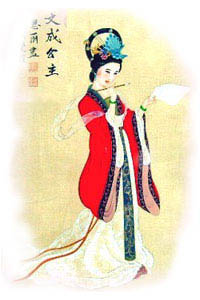|
A Han Princess and the Tibetan King
"The beauty leaves Chang'an When will she return?
Grass obscures the horse's hooves,
The north wind tousles her hair."
These lines reflect the melancholic mood in which Princess Wenzheng left her homeland to be married. A daughter of the Li clan, Princess Wenzheng was adopted by Tang Emperor Taizong (AD 627-649) and Empress Changsun. She was given in marriage to King Songzan Ganbu (AD 617-650), ruler of Tufan (Tibet).
Princess Wenzheng's marriage was just one example of the practice known as "heqin" by which clans and dynasties cemented diplomatic relations through marriage. When a Han princess became the bride of a barbaric leader, it was hoped that the alliance would promote harmonious relations and indeed such matches often promoted cultural exchanges, friendship and unity. For the lady involved, however, such a destiny was often viewed as a great misfortune.
King Songzan Ganbu was a brave and handsome king. When he was shown a portrait of Princess Wenzheng, he was struck by her air of dignified elegance. He sent a marriage proposal, but his hopes were dashed by King Tu Guhun of the Turkish tribe who spread slanderous rumours about him. King Songzan Ganbu, determined to have the princess for his bride, retaliated by gathering all his troops to attack Tu Guhun.Having routed his enemies, King Songzan Ganbu invaded Songzhou, a part of the great Tang empire. Emperor Taizong realised that King Songzan Ganbu was fighting not for control over the Tang epire, but for the hand of the princess. Consequently, he accepted his proposal and betrothed Princess Wenzheng to King Songzan Ganbu. In the fifteenth year of Emperor Taizong's reign, Princess Wencheng went on a long and arduous journey to the Tang border. King Songzan Ganbu had arrived much earlier to make arrangements for a grand ceremony. That same year, King Songzan Ganbu returned to Lhasa with Princess Wenzheng. He was overjoyed now that his dearest wish was fulfilled.
a Buddhist, he had two temples built for her. Because she was fond of willow trees, he had them planted everywhere. When she expressed her dislike for the local custom where people painted lines on their faces with burnt ochre, the king sent an order to forbid this century-old tradition. Finally, the king established a system of "rest posts" at one hundred mile intervals so that special messengers could carry letters and gifts to and from the Tang court.
Princess Wenzheng was touched by her husband's love for her and gradually came to care for him and her borderland home. She summoned Han artisans to Tufan to pass on their skills in metallurgy, farming, weaving, construction, milling, brewing and; the manufacture of paper and ink. The local farmers were taught new agricultural techniques to raise different varieties of grain. Han astronomy and the Chinese calendar were also introduced to the region. Perhaps the most important innovation was the writing system developed by Princess Wenzheng and the king, for before her arrival, Tufan was without a written language. Over the years, the princess' affection for the king grew deeper. It would be impossible to say whether the way he treated her stemmed from his respect for the Tang Dynasty or whether he admired Princess Wenzheng's homeland because of his love for her. However it was certainly true under his rule Tufan was one of China's most loyal tribute states.
As a "political bride" sent away to a strange and distant border land, Princess Winging could hardly have hoped that the man she was to marry would not only be a fine husband but also an outstanding monarch. Nor could she have dreamt that she would have the freedom to pursue her own interests or that she would come to enjoy the respect of her subjects.
was indeed both a diplomatic and a personal success.
www.span.com.au/100women
|
|
|
Tibet: between two worlds
Tibet is adjoined on the east by two Chinese provinces, Sichuan and Gansu. the Ti and the Zhiang, two peoples who were pastoral nomads in the Han Age, are said to be the ancestors of the present day Tibetans. Tibet was unified politically early in the 7th century, at a date at which China, too, had only just been reunified under the Tang Dynasty. Taizong, the second Tang emperor, sought to conciliate the Tibetans by giving the Princess Wenzheng to the Tibetan king in marriage. Queen Wenzheng arranged for the importation into Tibet of Chinese silks and for the invitation of Chinese scholars, whose services were for dealing with documents written in the Chinese characters. Eventually Chinese Buddhism, too, made its way into Tibet, and some of the Buddhist scriptures that had been translated into Chinese were now translated from Chinese into Tibetan.
|
|
|
However, a Nepalese princess had also been brought to Tibet as a consort for the king, and her arrival was followed by an active propagation of an Indian form of Buddhism, introduced by way of Nepal, from Bengal. Then, in the 7th century, a Tibetan script was devised on the pattern of an Indian script; the Buddhist scriptures were translated into the Tibetan language in this script; and this gave an impetus to the reception, in Tibet, of Buddhism in its Indian instead of its Chinese form. Even so, the Tibetan king's Chinese marriage alliance brought with it some benefits for both Tibet and China. One result was the importation into Tibet of the material products of Chinese civilization at the time of the Tang dynasty. A second result was the establishment of peaceful relations between Tibet and China. This contributed greatly to the development of Tibetan culture, and a statue of Princess Wenzheng was worshipped in Tibet in recognition of her cultural services.
Early in the 8th century there was another marriage alliance between the Tang dynasty and the royal family of Tibet, and thanks to the arrival of this second Chinese bride, the Princess Qinzheng, the importation into Tibet of the material products of Chinese civilization continued. But from the second half of the 7th century onwards the Tibetans became politically ambitious and aggressive. They invaded and occupied the Tang Empire's territory in what is now Xinjiang, and they then extended their military offensive to Qinghai, Sichuan and Gansu as well. After the middle of the 8th century the Tibetans took advantage of the domestic crisis that had then overtaken the Tang regime. A Tibetan army invaded Shenxi and even occupied Chang'an for a time. This military aggression had cultural effects of Tibet. The Chinese civilization of Gansu and Shenxi, particularly the mixture of cultural elements from the west, was adopted by members of the Tibetan Samgha during the Tibetan occupation and was brought back to Tibet by them. Yet the mainstream of Tibetan Buddhism, like the Tibetan script, was still Indian, not Chinese, and consequently the Chinese Buddhism of the Tang Age was never able to win in Tibet the hold that it won in Korea and Japan.
|
|
|
Bushnell, S.W. 'The Early History of Tibet' in Journal of the Royal Asiatic Society
(London, 1880)
Richardson, H.E. Tibet and its History
(London, 1962)
|
|



